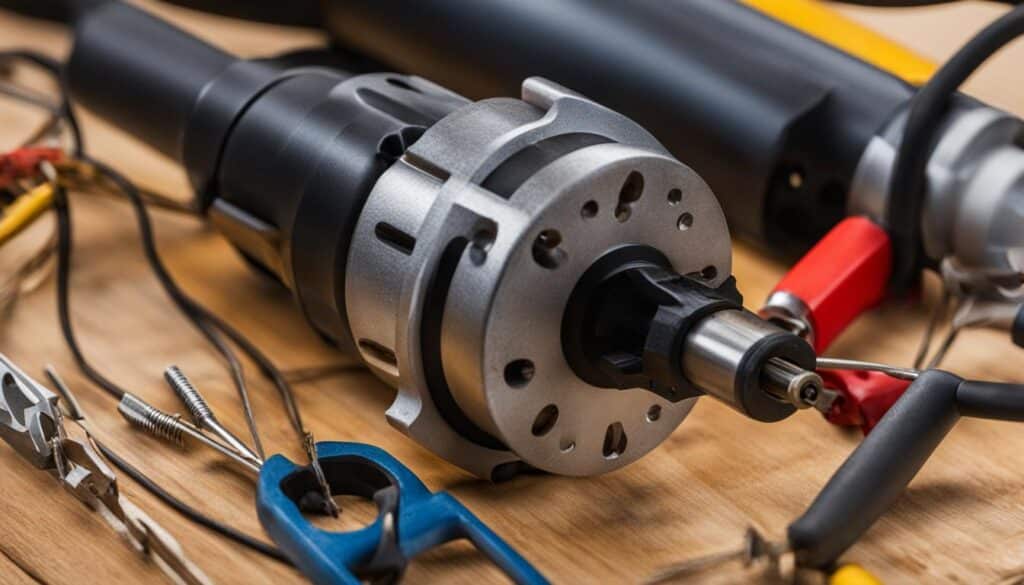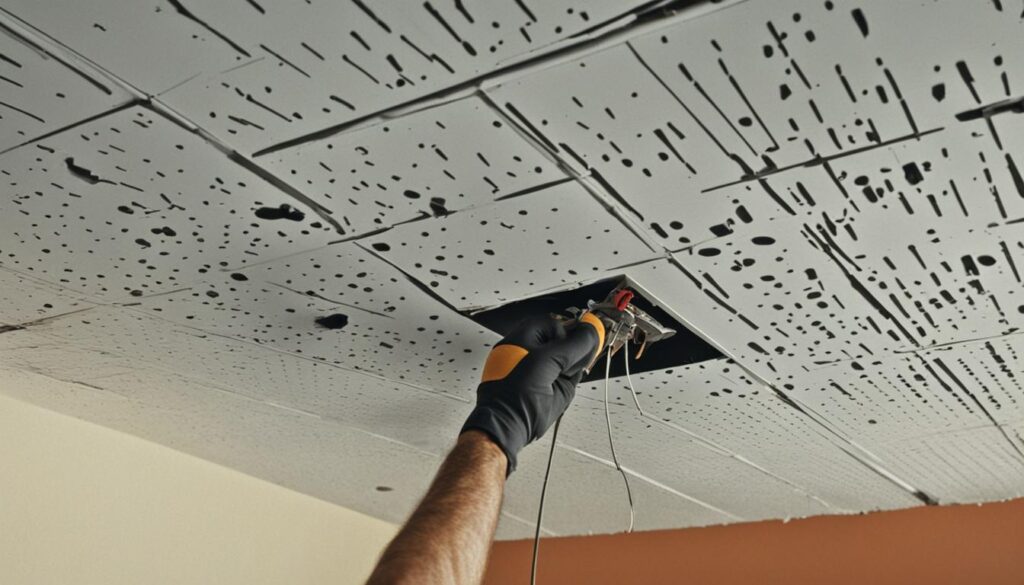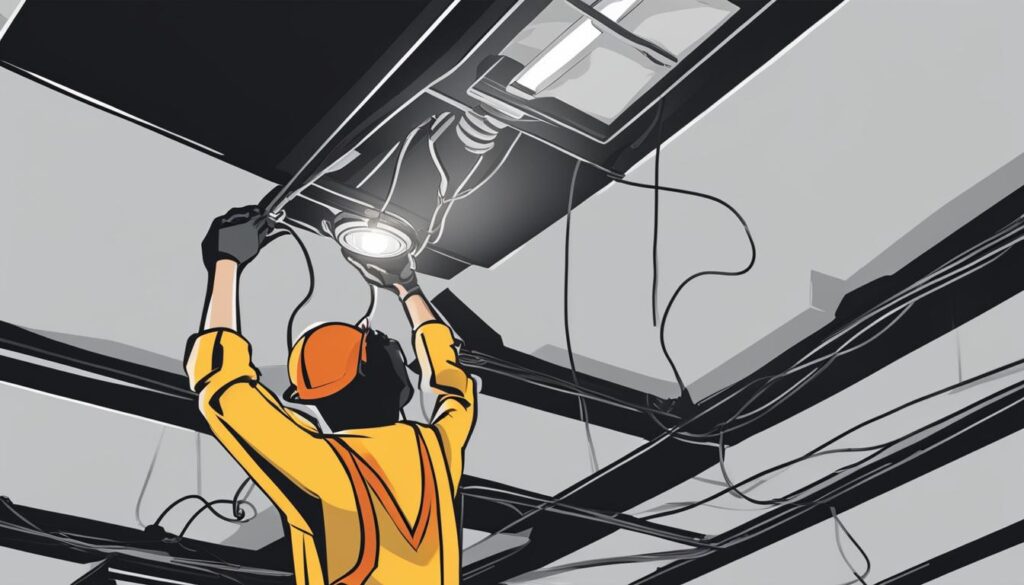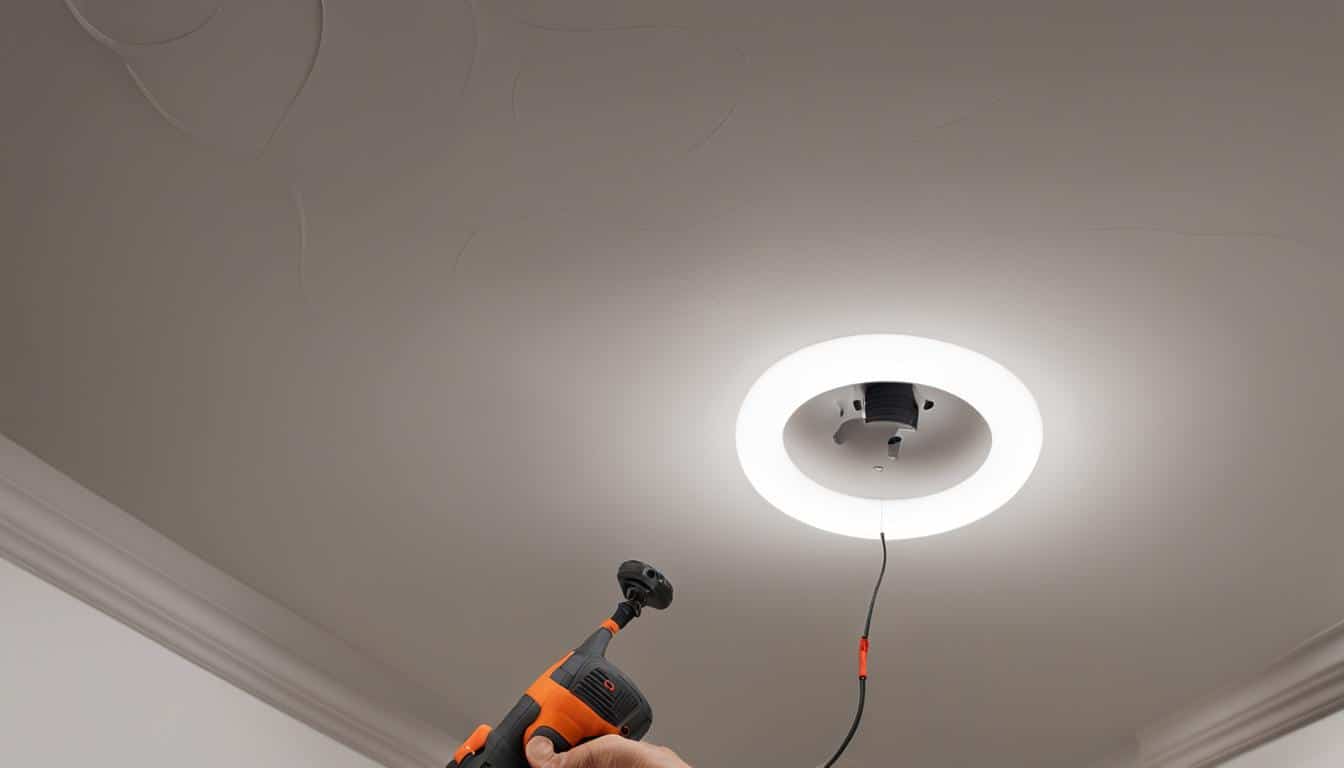Transforming an existing ceiling with canless recessed lighting is a straightforward process that involves turning off the power, preparing the installation spot, and connecting wires correctly. Utilizing the ultra-thin design of the canless LED recessed lights, the installation can be done almost anywhere without the need for a traditional, bulky housing that interferes with attic space. It offers an attractive, modern look and is energy-efficient, showing significant advantages over traditional options.
Key Takeaways
- Canless recessed lighting installation is a simple DIY project for existing ceilings.
- The ultra-thin design of canless LED lights eliminates the need for bulky housing.
- Canless recessed lights provide an energy-efficient, modern appearance.
- Safety is paramount during the installation process, including turning off power and using a voltage tester.
- Planning the layout and cutting precise holes in drywall is crucial for a polished look.
- Proper wiring connections ensure a safe and successful installation.
- Adding adjustable settings to your canless recessed lighting allows for a customized experience.
Understanding Canless Recessed Lighting
When it comes to adding a modern touch to your home’s lighting, canless recessed lighting offers versatile and energy-efficient solutions. But before diving into its benefits and installation process, it is essential to know the basics of canless LED recessed lighting and the advantages of using canless recessed lighting retrofit kits.
The Basics of Canless LED Recessed Lighting
Traditional recessed lighting requires the installation of bulky cans that take up valuable space in your ceiling. In contrast, canless LED recessed lighting boasts a slim design, being only about 1/2-inch thick. This makes it an ideal solution for tight spaces or areas where ceiling clearance is an issue. These ultra-thin fixtures often come with adjustable settings allowing you to switch between warm and cool light, ranging from 2700K to 5000K.
Advantages of Using Canless Recessed Lighting Retrofit Kits
Aside from their sleek appearance, canless recessed lighting retrofit kits offer many benefits, making them a popular choice for homeowners and professionals alike. They provide:
- Easy installation in various spaces due to the absence of large housing
- Adjustable light settings ranging from warm to cool, providing customization for any room
- Energy-efficient design, which helps reduce electricity bills and minimizes the environmental impact
- A more discreet and modern look compared to traditional recessed lighting options
In summary, canless recessed lighting retrofit kits offer an innovative and versatile solution to upgrade your home’s lighting. They boast a slim, attractive profile and enhanced energy efficiency, making them an attractive option for any lighting project.
Tools and Materials Needed for Installation
Before embarking on your step-by-step recessed lighting installation, it’s crucial to gather all necessary tools and materials for a successful project. Having the right equipment will not only make the installation process smoother but also ensure a professional and polished finish.
Here are the essential tools and materials you’ll need:
- Drywall saw or Dremel Multi-Max tool
- Electrical wire strippers
- Voltage tester
- Color-coded quick connectors
- Romex connectors
- Cable connectors
- Hole saw

Each item on this list serves a specific purpose in the recessed lighting installation guide. The drywall saw or Dremel Multi-Max tool is used to cut out holes based on the template provided in the light kit, ensuring a precise fit for your canless recessed lighting fixtures. Electrical wire strippers will come in handy when preparing wiring connections, while a voltage tester is essential for maintaining safety by confirming that the power is off before conducting any electrical work.
Additionally, you’ll need color-coded quick connectors for efficiently connecting wires and Romex connectors for secure cable connections. Cable connectors help ensure that the junction box is firmly attached to the light fixture. Finally, a hole saw offers an alternative method for cutting out the template on your ceiling, making it another invaluable tool for a seamless installation process.
With these tools and materials at your disposal, you’ll be well-equipped to tackle your canless recessed lighting installation and achieve professional-quality results.
Safety First: Preparing Your Workspace
Before learning how to install canless recessed lighting in existing ceiling, it’s crucial to prioritize safety. Taking preventive measures minimizes hazards associated with electrical installations.
Shutting Off the Power Properly
Always start by turning off the power at the breaker box. This ensures that the area is safe from electrical shocks during the installation process. Omitting this step can be dangerous and lead to accidents.
Important Safety Gear to Utilize
While undertaking a DIY canless recessed lighting project, utilizing proper safety gear helps prevent injuries. Wear safety glasses when drilling or cutting into drywall to protect your eyes. Additionally, use a voltage tester to confirm the electrical wiring is not live before starting any work. Employing the right safety gear and measures guarantees a hazard-free installation process.
Planning Your Recessed Lighting Layout in an Existing Ceiling
Before diving into recessed lighting installation, it’s essential to plan the layout of the lights for a balanced and functional scheme. A solid layout begins with marking the spots for your canless recessed lights. Depending on the room’s lighting needs, you might want to maintain equidistant gaps between the fixtures. However, always be mindful of daisy-chaining considerations if you’re installing canless recessed lights in multiple locations.

Begin by determining the ideal locations for your canless recessed lights. Assess the room’s lighting requirements and visually imagine your desired outcome. With that in mind, grab a tape measure and a pencil, and start laying out each light’s location.
Measure the distance between the fixtures and ensure that they are equally spaced. Transfer your measurements onto the ceiling and make a small mark using a pencil. Don’t forget to include any daisy chaining connection points for multiple lights.
Considering the existing ceiling structure, you might need to make minor adjustments to your initial layout plan. For example, you may need to avoid ceiling joists or other obstructions to install the canless lights. Keep a lookout for wiring in the ceiling and be prepared to modify the layout if required.
Tip: When planning the layout, be mindful of the room’s purpose, the desired lighting effect, and the kind of canless recessed lighting model you have chosen. This will help determine the optimal lamp placement and ensure a well-lit space.
Once you finalize your recessed lighting layout, you’re ready to proceed with the next steps of the installation process. With a well-planned layout, installing canless recessed lights in an existing ceiling can be a smooth and rewarding experience.
How to Cut the Drywall for Canless Lights
Properly cutting the drywall for canless lights is an essential step in your step-by-step recessed lighting installation. This ensures a seamless installation process and professional result. In this section, we will discuss the importance of using the right tools for cutting and the process of tracing the template onto the ceiling.
Using the Right Tools for Precise Cutting
To achieve a clean cut when installing canless recessed lighting, it’s crucial to use the appropriate tools. A drywall saw or a Dremel Multi-Max tool is perfect for making precise cuts in the ceiling. A careful selection of the suitable blade is essential to ensure a neat finish and easy installation. Below is a comparison between these tools:
| Tool | Description | Pros | Cons |
|---|---|---|---|
| Drywall Saw | A handheld saw with a sharp serrated blade designed for cutting drywall | Easy to use, affordable, and provides clean cuts | Requires manual labor and may not be suitable for large-scale projects |
| Dremel Multi-Max | A versatile oscillating tool with multiple attachments for cutting, grinding, and sanding | Adaptable, quick, and offers professional results | More expensive and may require a learning curve for new users |
Tracing the Template and Efficient Drywall Removal
Using the template included with the canless light kits, trace the correct size for your lights onto the ceiling to ensure a precise cut. Be sure to account for any obstructions or fixtures that may be in the way, such as joists or electrical components. Once the template is traced onto the ceiling, it’s time to cut out the marked area:
- Choose your cutting tool for either manual or powered cutting.
- Follow the traced outline carefully to ensure an accurate cut.
- Check the fit of the canless light to make sure it is proper before proceeding with the installation.
By carefully following these steps, you will create a perfect opening in the drywall that will allow for a smooth canless recessed lighting installation.
Wiring Connections for Canless Recessed Lights
Proper wiring connections are crucial for a safe and successful canless recessed lighting setup. Following a systematic approach ensures a secure electrical connection inside the junction box.

- Knock out a hole on the light’s metal housing and feed the ceiling wires through.
- Connect all corresponding wires – black with black, white with white, and the bare wire with the green (ground).
- Use push-in connectors to streamline the process and ensure secure connections.
For those installing canless recessed lights as part of a larger project or with multiple fixtures, investing in a canless recessed lighting retrofit kit might prove beneficial. These kits often include essential components and connectors, simplifying the installation process.
Important tip: When working with electrical wiring, always verify that the power is turned off and use a voltage tester to ensure the wires are not live before making connections.
By adhering to the above-listed steps and diligently following safety precautions, a secure and effective canless recessed lighting setup is achievable, adding both aesthetic value and energy-saving functionality to any room.
Installing Canless Recessed Lighting in an Existing Ceiling
Learning how to install canless recessed lighting in an existing ceiling is a rewarding skill for homeowners looking to enhance the look and feel of their living spaces. With a few simple steps and some safety precautions, the canless recessed lighting installation process can be easily tackled as a DIY project or with professional assistance.
Start by turning off the power at the circuit breaker to ensure a safe working environment. Next, mark and cut holes for each fixture on the ceiling using the supplied template and a suitable cutting tool, such as a drywall saw or Dremel Multi-Max. Be sure to double-check the size and placement before proceeding with installation.
After cutting the holes, prepare the junction box by removing any knockouts and inserting cable connectors. Feed the existing ceiling wires through the junction box and follow the color-coded quick connectors to connect black (hot) wires together, white (neutral) wires together, and bare (ground) wires with green (ground) wires.
Once all the wires have been connected, close up the junction box and prepare the canless recessed lighting fixture. Ensure the fixture is compatible with your ceiling type and that it has the necessary spring-loaded wings or clips to hold it securely in place. Attach the fixture to the existing ceiling by pushing it firmly upward until it clicks into place and sits flush with the ceiling surface.
Finally, test your new canless recessed lights by turning the power back on at the circuit breaker. Admire your handiwork and enjoy the sophisticated ambiance that your canless recessed lighting installation brings to your home.
Connecting and Securing the Canless Lights
Installing multiple canless recessed lights in an existing ceiling may require connecting them in a series, known as daisy-chaining. Proper daisy-chaining and securing of the lights result in a seamless and professional installation.

Dealing with Multiple Light Fixtures
When handling multiple canless recessed light fixtures, it’s crucial to daisy-chain them correctly for a successful installation. This process involves connecting an outgoing wire from the junction box of one light to the incoming terminal of the next fixture’s box. To attain a daisy-chained network, continue connecting the wires in the same manner until the last light in the series.
Finishing the Installation Series Correctly
Upon reaching the last light fixture in the series, it is essential to ensure that no loose wires are present. It’s acceptable to leave an empty slot in the terminal of the final light. Once all fixtures are wired and secured in their respective positions, check that each light is flush with the ceiling surface. Most canless recessed lighting retrofit kits come with spring-loaded wings or clips that help maintain a secure fit against the ceiling. Utilize these clips accordingly to finalize the installation process.
Finishing Touches and Testing

After completing the canless LED recessed lighting installation, it is crucial to perform a thorough check to ensure all connections are secure, and junction boxes are properly closed. Once the wiring and fixtures are in place, restore the power and test the lights to confirm that the installation process has been successful.
For adjustable lighting models, check the light settings prior to sealing the fixtures. LED lights offer different brightness levels and colors, which should be tested before considering the installation complete. The table below illustrates the various settings and their corresponding values:
| Setting | Brightness | Color Temperature |
|---|---|---|
| Low | 300 Lumens | 2700K (Warm White) |
| Medium | 600 Lumens | 4000K (Neutral White) |
| High | 900 Lumens | 5000K (Cool White) |
In conclusion, following this comprehensive recessed lighting installation guide will help you achieve a professional-looking and safe installation of canless LED recessed lights in your existing ceiling. Enjoy the numerous benefits and the aesthetic transformation these fixtures bring to your home.
Conclusion
Undertaking a canless recessed lighting installation in an existing ceiling can prove to be a rewarding DIY project that elevates both the aesthetics and functionality of any room. By meticulously following the outlined steps and sticking to safety guidelines, one can achieve professional-quality lighting without much hassle. The canless LED lights’ minimalist design and elegance have the power to transform living spaces, imparting them with energy efficiency and the advantage of adjustable settings.
By doing away with the need for bulky housing, canless LED lights offer unparalleled flexibility, allowing them to be installed in various spaces that might have been previously impossible to navigate. As a result, they open up a whole new world of lighting possibilities for homeowners who are looking to update their interiors and enhance the overall ambiance of their living spaces.
In conclusion, installing canless recessed lighting in an existing ceiling is a valuable investment that pays off in terms of improved visual appeal and energy savings. With the right tools and adherence to safety measures, anyone can take on this project and revel in the transformative impact that elegant, customizable lighting can have on one’s home.
FAQ
What are the advantages of canless recessed lighting over traditional options?
Canless recessed lighting offers several benefits, including a slim profile that doesn’t require large housing, making it suitable for various spaces. These lights also provide adjustable lighting settings and enhanced energy efficiency, allowing for a more discreet and versatile lighting solution.
What tools and materials are needed for canless recessed lighting installation?
To install canless recessed lighting, you’ll need a drywall saw or Dremel Multi-Max tool, electrical wire strippers, a voltage tester, color-coded quick connectors, Romex connectors, cable connectors, and a hole saw. Having these tools ensures a clean cut and secure installation of the junction box to the light fixture.
What safety precautions should be taken during canless recessed lighting installation?
Before starting, turn off the power at the breaker box and wear safety glasses when drilling or cutting drywall. Use a voltage tester to ensure the electrical wiring is not live before beginning any work. Following proper safety measures keeps the installation process hazard-free.
How do I plan the layout for recessed lighting in an existing ceiling?
Mark the spots for your recessed lights, keeping equidistant gaps or basing the layout on the room’s lighting needs. Use a tape measure and pencil to lay out each light’s location, including any daisy-chaining considerations for multiple fixtures.
What is the process for cutting drywall for canless lights?
Use the template provided with the light kit to trace the correct size onto the ceiling. Cut out the marked area with a drywall saw or a suitable cutting tool like a Dremel Multi-Max, ensuring the light fits properly before proceeding.
How do I connect wires for canless recessed lighting?
After knocking out a hole on the light’s metal housing and feeding the ceiling wires through, connect all corresponding wires—black with black, white with white, and the bare wire with the green (ground). Use push-in connectors to streamline the process and ensure secure electrical connections inside the junction box.
How do I daisy-chain multiple canless recessed light fixtures?
Connect an outgoing wire from the junction box of one light to the incoming terminal of the next fixture’s box. Leave an empty slot in the terminal of the last light in the series. Ensure each light fixture is secure and flush with the ceiling surface using spring-loaded wings or clips.

